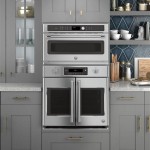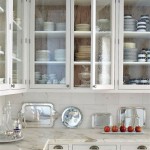How To Organize A Kitchen Corner Cabinet
The kitchen corner cabinet, often found in L-shaped or U-shaped kitchen layouts, presents a unique organizational challenge. Its depth and awkward shape can make accessing items stored within difficult, leading to wasted space and forgotten goods. Effective organization, however, transforms this problematic area into a functional and efficient storage solution. This article provides a comprehensive guide on how to maximize the utility of a kitchen corner cabinet through strategic planning and implementation.
Before embarking on the organizational process, it's crucial to assess the existing state of the corner cabinet. This involves completely emptying the cabinet's contents. Remove all items, including cookware, pantry staples, and seldom-used appliances. This step provides a clear understanding of the available space and the types of items that are typically stored within the cabinet.
Once the cabinet is empty, thoroughly clean the interior surfaces. This includes vacuuming any debris, wiping down shelves, and addressing any stains or spills. A clean surface provides a fresh start and prevents the accumulation of dust and grime, which can affect the hygiene of stored items.
Inventory and Categorization
After cleaning, the next step is to inventory all of the removed items. This involves carefully examining each item and determining its purpose, frequency of use, and condition. Discard any expired food items, broken kitchenware, or items that are no longer needed. This decluttering process streamlines the organization and prevents unnecessary items from occupying valuable space.
Categorizing items based on their function or frequency of use is essential for efficient storage. Common categories include cookware (pots, pans, baking sheets), pantry staples (canned goods, dry ingredients), small appliances (blenders, food processors), and serving dishes. Grouping similar items together simplifies retrieval and prevents items from being misplaced.
Consider the frequency with which each item is used. Items that are used daily or weekly should be placed in easily accessible locations within the cabinet. Items that are used infrequently can be stored in the back or in higher shelves. This prioritization ensures that frequently used items are always within reach, while less frequently used items remain out of the way.
Evaluate the available space within the corner cabinet and determine the best way to utilize it for each category. This may involve measuring the dimensions of the cabinet and shelves, as well as considering the shape and size of the items to be stored. Proper space planning ensures that all items can be accommodated within the cabinet without overcrowding.
Selecting Organizational Tools
Various organizational tools are available to enhance the functionality of a corner cabinet. The choice of tools depends on the specific needs and preferences of the user, as well as the configuration of the cabinet itself. These tools aid in maximizing space utilization and improving accessibility.
Lazy Susans are rotating turntables that can be placed on shelves or directly on the cabinet floor. They allow for easy access to items stored in the back of the cabinet by simply rotating the turntable. This is particularly useful for storing canned goods, spices, or other small items that can easily get lost in the depths of the cabinet.
Pull-out shelves provide increased accessibility to items stored in the back of the cabinet. These shelves slide out, allowing users to view and retrieve items without having to reach deep into the cabinet. They are particularly useful for storing heavier items, such as pots and pans, which can be difficult to lift from the back of the cabinet.
Tiered shelves create vertical storage space by dividing the height of a shelf into multiple levels. This allows for stacking items without blocking access to those behind. They are useful for storing plates, bowls, or other items that can be stacked vertically.
Corner cabinet organizers are specifically designed to fit the unique shape of a corner cabinet. These organizers typically feature multiple shelves and compartments that maximize space utilization and provide easy access to stored items. They can be purchased as standalone units or as part of a complete cabinet organization system.
Baskets and bins are useful for storing small items or for grouping items together. They can be used to store pantry staples, cleaning supplies, or other items that tend to clutter the cabinet. Transparent bins allow for easy identification of contents, while labeled bins help to categorize and organize items effectively.
Consider using shelf dividers to prevent items from toppling over or sliding around within the cabinet. Shelf dividers can be used to separate stacks of plates, organize cookware, or keep pantry items neatly arranged. They help to maintain order and prevent items from shifting during opening and closing of the cabinet door.
Hanging organizers can be installed on the inside of the cabinet door to provide additional storage space. These organizers are useful for storing small items, such as measuring cups, utensils, or cleaning supplies. They maximize the use of available space and keep frequently used items within easy reach.
Implementing the Organization Plan
With the organizational tools selected, the next step is to implement the organization plan. This involves strategically placing items within the cabinet to maximize space utilization and improve accessibility. The key is to create a system that is logical, efficient, and easy to maintain.
Begin by placing the most frequently used items in the most accessible locations within the cabinet. This typically includes items that are used daily or weekly, such as cookware, pantry staples, and serving dishes. These items should be placed on the lower shelves or in the front of the cabinet for easy retrieval.
Store heavier items on the lower shelves of the cabinet to prevent strain when lifting. Pots, pans, and small appliances should be placed on the bottom shelves for stability and ease of access. This also reduces the risk of items falling and causing injury.
Utilize the selected organizational tools to maximize space utilization and improve accessibility. Install lazy Susans, pull-out shelves, tiered shelves, and corner cabinet organizers as needed. Arrange items within baskets, bins, and shelf dividers to create order and prevent clutter.
Consider the vertical space within the cabinet and utilize it effectively. Stack plates and bowls using tiered shelves, and store taller items on the upper shelves. Adjust the height of adjustable shelves to accommodate different sized items and maximize the available space.
Ensure that all items are clearly visible and easily accessible. Avoid stacking items too high or overcrowding shelves, as this can make it difficult to retrieve items from the back of the cabinet. Leave some space between items to allow for easy access and prevent them from becoming damaged.
Label shelves, bins, and containers to clearly identify the contents of each. This makes it easier to locate items quickly and prevents items from being misplaced. Use clear labels that are easy to read and update them as needed to reflect any changes in the organization.
Regularly maintain the organized state of the corner cabinet by periodically decluttering and rearranging items as needed. This prevents the cabinet from becoming disorganized over time and ensures that the organizational system remains effective. Aim to declutter the cabinet at least once a year, or more frequently if needed.
Consider the lighting within the corner cabinet. Poor lighting can make it difficult to see items stored in the back, which can lead to forgotten goods and wasted space. Install additional lighting, such as LED strip lights or under-cabinet lights, to improve visibility and make it easier to locate items.
By following these guidelines, an individual can transform a challenging kitchen corner cabinet into a functional and efficient storage space. Effective organization not only improves the usability of the kitchen, but also saves time and effort in the long run.

Iheart Organizing Organized Kitchen Corner Cabinet With A Diy Lazy Susan

Iheart Organizing Organized Kitchen Corner Cabinet With A Diy Lazy Susan

Kitchen Organization Ideas Corner Cabinet

Organizing A Corner Kitchen Cabinet Organize Your Frugally Day 16 Homelife

Iheart Organizing Organized Kitchen Corner Cabinet With A Diy Lazy Susan

Corner Cabinet Organizers Kitchen Storage Ideas

How To Deal With The Blind Corner Kitchen Cabinet Live Simply By Annie

Corner Cabinet Organizers Kitchen Storage Ideas

How To Organize Corner Kitchen Cabinets The Homes I Have Made

How To Organize Corner Kitchen Cabinets 5 Great Ideas Consider In 2024 Cabinet Cupboards Organization








